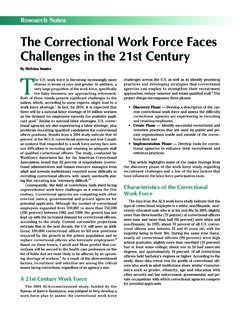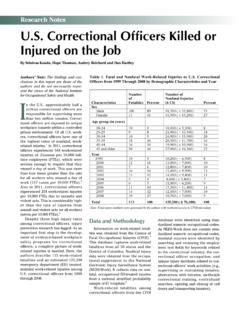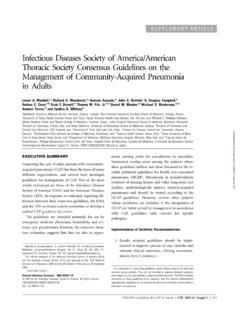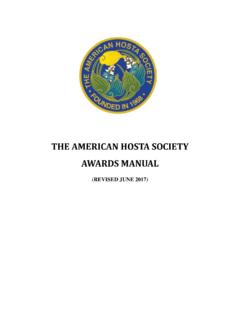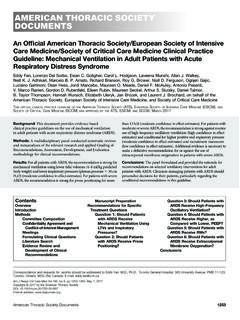Transcription of American Correctional Association and American …
1 FOR IMMEDIATE RELEASE MARCH 20, 2018. Contact: Jeff Washington, Deputy Executive Director, ACA, Alexandria, VA. 703-224-0103. Contact: Bob Davis, VP, Marketing, Membership & Engagement, ASAM, Chevy Chase, MD. 301-547-4112. American Correctional Association and American society of Addiction Medicine Release Joint Policy Statement on Opioid Use Disorder Treatment in the Justice System Statement supports access to all evidence-based treatment options The American Correctional Association (ACA) and the American society of Addiction Medicine (ASAM). released today a Joint Public Correctional Policy on the Treatment of Opioid Use Disorders for Justice Involved Individuals. The statement includes recommendations to support Correctional policy makers and Correctional healthcare professionals in providing evidence-based care to those in their custody or under their supervision who have an opioid use disorder.
2 In supporting this joint policy statement, Dr. Lannette Linthicum, President of the ACA and a physician, believes that the corrections environment provides an ideal setting for the treatment of substance use disorders for those in the justice population. According to Dr. Linthicum, we know that substance use disorders, including opioid use disorders, are markedly overrepresented in our incarcerated populations. This partnership with ASAM will enable us to enhance the treatment of our patients with substance use disorders. As we move forward together, these efforts will help change the course of the nation's opioid crisis.. ASAM is pleased to join ACA in releasing this important statement, which makes clear that justice- involved individuals should have access to the same evidence-based treatment options that are available in traditional healthcare settings, said ASAM President Dr.
3 Kelly Clark. We know that release from jail and prison is associated with a dramatic increase in death from opioid overdose among those with untreated opioid use disorder, and providing treatment access during incarceration and warm handoffs to community-based care upon release can help save lives.. The statement's recommendations cover screening, prevention, and treatment of opioid use disorder as well as reentry and community supervision considerations and education of justice system personnel. The full statement can be found on ACA's website here and ASAM's website here. Page 1|2. The American Correctional Association (ACA) is a professional membership organization composed of individuals, agencies and organizations involved in all facets of the corrections field, including adult and juvenile services, community corrections, probation and parole, jails and Correctional public health.
4 It has thousands of members in the United States, Canada and other nations, as well as over 100 chapters and affiliates representing states, professional specialties, or university criminal justice programs. For more than 148 years, ACA has been the driving force in establishing national Correctional policies and advocating safe, humane and effective Correctional operations. Today, ACA is the world-wide authority on Correctional policy and performance base standards and expected practices, disseminating the latest information and advances to members, policymakers, individual Correctional professionals and departments of correction. ACA was founded in 1870 as the National Prison Association and became the American Prison Association in 1907.
5 At its first meeting in Cincinnati, the assembly elected Rutherford B. Hayes, then governor of Ohio and later president, as the first president of the Association . At that same meeting, a Declaration of Principles was developed, which became the accepted guidelines for corrections in the United States and Europe. At the ACA centennial meeting in 1970, a revised set of principles reflecting advances in theory and practice was adopted. These principles were further revised and updated in January 1982 and in 2002. The American society of Addiction Medicine is a national medical specialty society representing over 5,500 physicians and associated professionals. Its mission is to increase access to and improve the quality of addiction treatment, to educate physicians, and other health care providers and the public, to support research and prevention, to promote the appropriate role of the physician in the care of patients with addictive disorders, and to establish Addiction Medicine as a specialty recognized by professional organizations, governments, physicians, purchasers and consumers of health care services and the general public.
6 ASAM was founded in 1954, and has had a seat in the American Medical Association House of Delegates since 1988. Page 2|2. JOINT PUBLIC Correctional POLICY ON THE TREATMENT OF OPIOID USE. DISORDERS FOR JUSTICE INVOLVED INDIVIDUALS. 2018-2. Introduction: Seventeen to nineteen percent of individuals in America's jail and state prison systems have regularly used heroin or opioids prior to While release from jail and prison is associated with a dramatic increase in death from opioid overdose among those with untreated opioid use disorder (OUD), there are considerable data to show that treatment with opioid agonists and partial agonists reduce deaths and improves outcomes for those with opioid use ,iii Preliminary data suggest that treatment with an opioid antagonist also reduces As a result, the 2017 bipartisan Presidential Commission on Combating Drug Addiction and the Opioid Crisis has recommended increased usage of medications for addiction treatment (MAT)
7 In Correctional Policy Statement: The American Correctional Association (ACA) supports the use of evidence-based practices for the treatment of opioid use disorders. ACA and the American society of Addiction Medicine (ASAM) have developed recommendations specific to the needs of Correctional policy makers and healthcare professionals. These recommendations will enable Correctional administrators and others, such as community corrections, to provide evidence-based care to those in their custody or under their supervision that have opioid use disorders. ASAM recently published a document entitled The National Practice Guideline for the Use of Medications in the Treatment of Addiction Involving Opioid Usevi that includes treatment recommendations specifically for individuals in the justice system.
8 Pharmacotherapy, behavioral health treatment, and support services should be considered for all individuals with OUD that are involved in the justice system. ACA and ASAM recommend the following for Correctional systems and programs: A. Screening/Prevention 1. Most deaths from overdose occur during the first few days following intake to the Correctional facility. Screen all incoming detainees at jails and prisons using screening tools with psychometric reliability and validity that provide useful clinical data to guide the long-term treatment of those with OUD and with co-occurring OUD and mental disorders. Opioid antagonist (naloxone) should be available within the facility and personnel should be trained on its use.
9 2. Pre-trial detainees screened upon entry that are found to be participating in an MAT program to treat OUD and who are taking an opioid agonist, partial agonist, or antagonist should be evaluated for continuation of treatment on that medication, or a medication with similar properties. There are effective models for continuing treatment with each of these medications in the justice system. 3. Pre-trial detainees and newly admitted individuals with active substance use disorders who enter with or develop signs and symptoms of withdrawal should be monitored appropriately and should be provided evidence-based medically managed withdrawal ( detox ) during the period of withdrawal. Validated withdrawal scales help gauge treatment.
10 Several medications have been shown to improve withdrawal symptoms. B. Treatment 1. All individuals who arrive into the Correctional system who are undergoing opioid use disorder treatment should be evaluated for consideration to continue treatment within the jail or prison system. Individuals who enter the system and are currently on MAT and/or psychosocial treatment should be considered for maintenance on that treatment protocol. 2. Treatment refers to a broad range of primary and supportive services. 3. The standard of care for pregnant women with OUD is MAT and should therefore be offered/continued for all pregnant detainees and incarcerated individuals. 4. All individuals with suspected OUD should be screened for mental health disorders, especially trauma-related disorders, and offered evidence-based treatment for both disorders if appropriate.


